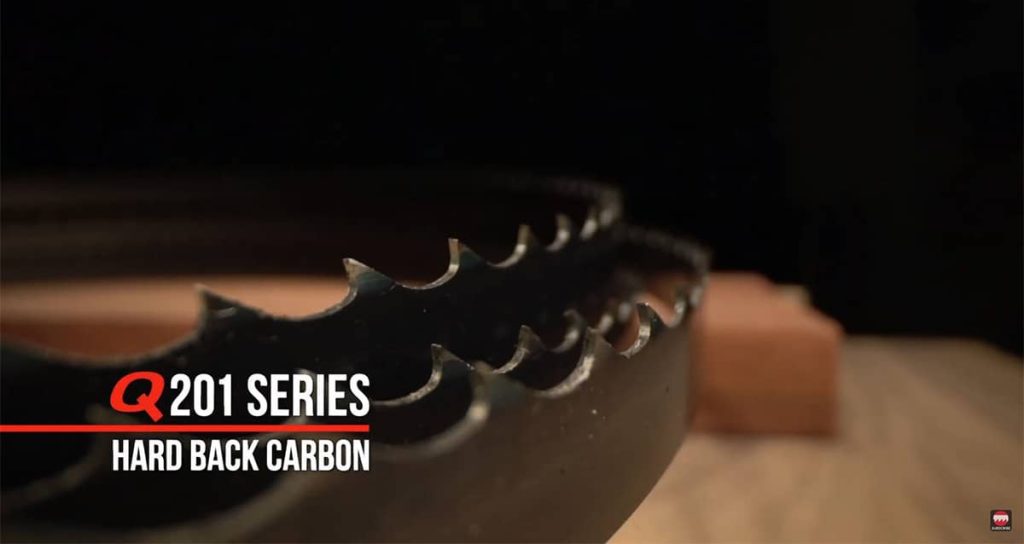Understanding the Delta 28-160 Bandsaw
The Delta 28-160 is a 9-inch benchtop bandsaw often found in home workshops and small job shops. Known for its compact size and solid performance in light-duty tasks, it’s best suited for wood and light material cutting. To get clean, accurate results, selecting the correct blade size and type is essential.
Recommended Blade Specs for the Delta 28-160
-
Blade length: 62 inches
-
Blade width range: 1/8″ to 3/8″
-
Compatible tooth pitch (TPI): 3 to 18 TPI
-
Blade type: Carbon steel – Hard Back or Flex Back
-
Cut types: Straight cuts, light resawing, curves, and contours
-
Material suitability: Wood, plastics, non-ferrous metals
Blade Length: Why 62 Inches Matters
The 62-inch blade length is the manufacturer-recommended size for the Delta 28-160. This ensures the blade sits correctly on the wheels, maintains proper tension, and tracks accurately. Using the wrong length can result in poor cutting performance, excess wear, or even safety issues.
Ideal Blade Width for Your Work
Blade width affects how the saw handles curves or resawing. While the Delta 28-160 can accept blades from 1/8″ to 3/8″, choosing the right width depends on your project needs. Thinner blades allow for tighter curves, while wider blades are better for straight cuts or light resawing.

Tooth Pitch and Blade Type Guide
| Tooth Pitch (TPI) | Best Use Cases | Blade Type Recommended |
|---|---|---|
| 3–6 TPI | Fast woodcuts, light resawing | Qsaw 101 Flex Back |
| 6–10 TPI | General woodcutting, soft metals | Qsaw 201 Hard Back / Flex Back |
| 10–18 TPI | Plastics, aluminum, clean finish in wood | Qsaw 101 Flex Back |
| 18–24 TPI | Thin metals, smoother detail work | Qsaw 201 Hard Back |
Qsaw 101 and 201: Blades that Fit the Delta 28-160
Both the Qsaw 101 Flex Back and Qsaw 201 Hard Back series offer excellent performance on the Delta 28-160. The 101 is ideal for woodworking, plastic, and non-ferrous metals, while the 201 adds more rigidity and edge strength for cleaner cuts in a variety of materials.
Benefits of the Right Blade Setup
-
Improves cut accuracy
-
Reduces blade wear and breakage
-
Allows smoother operation with less vibration
-
Enables cleaner edges and faster material removal

Common Uses for the Delta 28-160 with Proper Blade
The Delta 28-160 is versatile when paired with the right blade. Whether you’re shaping curves, ripping stock, or cutting soft metals, the right blade unlocks a range of possibilities for home-based or light-duty workshop projects.
Where to Find Compatible Blades
-
Qsaw official site
-
Bandsaw specialty retailers
-
Tool and machinery supply stores
-
Online sellers offering custom 62-inch blade welding
Looking for Details on the Delta 28-203?
If you’re working with the Delta 28-203 or considering adding one to your shop, make sure to check out our article “Delta 28-203 Bandsaw: Full Overview and Blade Sizing Guide.” It covers everything you need to know from blade length and width recommendations to performance tips and material compatibility. Whether you’re replacing a blade or learning the machine’s full capabilities, this guide will help you get the most out of your Delta 28-203.
Fitting your Delta 28-160 with a properly sized 62-inch blade and selecting the appropriate width and TPI can make a significant difference in performance. Whether you’re using a Qsaw 101 for its flexibility or a Qsaw 201 for its cutting strength, the right blade ensures smoother operation, cleaner cuts, and extended machine life. Pay attention to the blade specs, and your Delta 28-160 will reward you with consistent, reliable results.